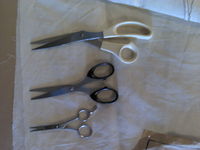Equipment/Cutting Table
| Fabric cutting table | |
|---|---|
 | |
| Model | Unknown |
| Sub-category | Crafts |
| Status | Good working order |
| Consumables | Unknown |
| Accessories | Unknown |
| Training link | Unknown |
| Owner | Unknown |
| Origin | Unknown |
| Location | Arts/crafts area |
The Cutting Table
The cutting table lives under the shelving next to lovelace and babbage.
It has a lid.
When the lid is on, the cutting table may be used like any other table. Please try to keep as clear as the other tables.
If it is not being used for cutting, the lid should be on top of the table.
The cutting surface is lined with cork. Cork is expensive and tricky to replace. It is also flammable and susceptible to water damage. Therefore the cork is covered with kraft paper. When this gets too dirty or torn, it should be replaced.
To replace it, either turn the paper upside down so the cutting surface falls out of the frame, or lever it out (use the wrong end of a fork or a butter knife blade.) Remove old paper and rewrap tightly in fresh paper, using drawing pins or masking tape to secure it in place. Reseat the cutting surface in the frame.
When the lid is off, the cutting table is for cutting out fabric with scissors or shears.
It is not for cutting with rotary cutter knives or razor blades or hatchets or lasers. There is a green mat for that.
NO FOOD or DRINK is allowed on the table in this state.
DO NOT put HOT THINGS on it in this state.
Fabric and pattern pieces may be pinned into place with long sewing pins or thumb tacks (drawing pins) or marking pins. Bear in mind that the cork is 2mm thick; after that you are pushing into denser Sundeala. It may be difficult to remove thumb tacks.
Another technique is to use weights -- large washers or map weights or particularly somnolescent felines -- to keep the pattern pieces and fabric from shifting.
Choice of scissors is up to the user. Please remember that pointy scissors (such as those pictured above left and center may dig into the cork and damage it.) Most appropriate are angled tailor's shears as on the right.
When you are done cutting, please remove all fabric, pattern pieces, pins and other tools, and replace the lid.
There is a shallow well at one end that will hold small items (Tailor's chalk, pins, shears and the like) with out fear of knocking them off the top while the table is in use. It may be large enough to place a standard sewing machine in.
There is a rumor of Hackspace-owned tailor's shears. If these turn out to exist, they could live permanently in the well.




